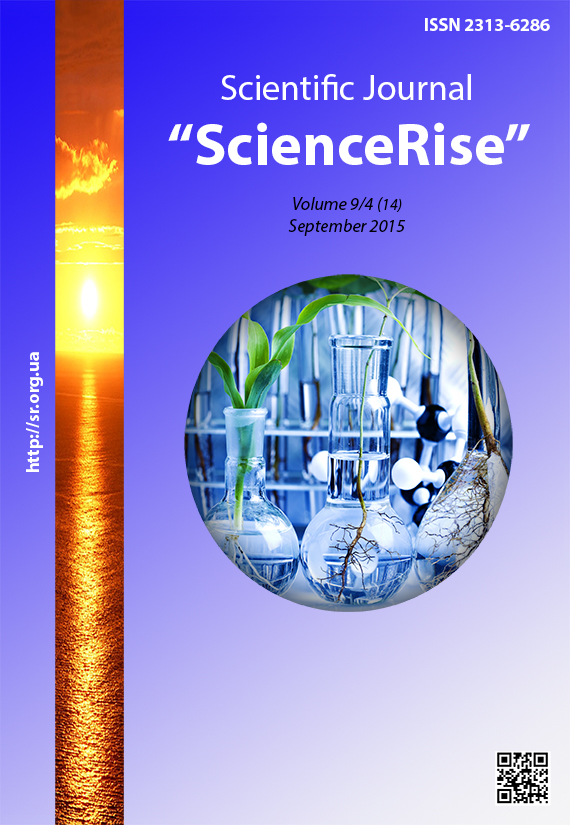Individual features of autoimmune disoders in patients with arterial hypotension in structure of neurologic symptom complexes of organic lesion of the central nervous system
DOI:
https://doi.org/10.15587/2313-8416.2015.49095Keywords:
Arterial hypotension, phenotype, immune resistance, central nervous system, stress, craniocerebral traumaAbstract
This work deals with the special features of formation of individual clinical phenotype with an evident humoral sensitizing in patients with arterial hypotension in structure of neurologic symptom complexes of organic lesion of the central nervous system in accordance with the features of disorders of immune resistance and changes of the hormonal background.
Materials and methods. There was carried out an examination of 201 patients: 89 with vegetative dysfunction, 50 in remote period of the closed craniocerebral trauma and 64 with cerebral arachnoiditis on the background of the chronic nidi of infection.45 examined persons with physiological arterial hypotension formed a control group. There were carried out clinical and neurological examinations, monitoring of arterial pressure, definition of the state of the primary, secondary immunity and hormonal background.
Results. The main pathogenetic mechanisms in individual clinical phenotype with an evident humoral sensitizing that were formed on the background of the chronic infection are more connected with the humoral link of immunity (the high concentration of circulating immune complexes of the small values of molecular weight and peptides of the mean molecular weight, the growth of IgM content) and form autoimmune disorders. This category can be related to the patients with irreversible functional states that complicates prescription of therapeutic measures.
Conclusions. For patients with an evident humoral sensitizing it is reasonable to use desensitizing preparations, enterosorbents, plasmapheresis in the complex treatment. At persistent viral infection the use of specific antiviral immunoglobulins of IgG is recommended
References
Aronov, D. M., Zajcev, V. P. (2002). Metodika ocenki kachestva zhizni bol'nyh s serdechnososudistymi zabolevanijami. Kardiologija, 5, 92–95.
Shardin, S. A., Kuz'min, Ju. F., Shardina, L. A., Najdanova, T. A., Berezovskaja, L. V.; Shardina, S. A. (Ed.) (2004). Arterial'nye gipotenzii u zhenshhin trudosposobnogo vozrasta. Ekaterinburg: Uchebnaja kniga, 131.
Belozerova, Ju. M., Caregorodceva, A. D., Tabolina, V. A. (Ed.) (2004). Nejrocirkuljatornaja distonija. Rukovodstvo po farmakoterapii v pediatrii i detskoj hirurgii. Moscow: Medpraktika-M, 170–172.
Vejna, A. M. (Ed.) (2000). Vegetativnye rasstrojstva: klinika, diagnostika, lechenie. Moscow, 624.
Krylov, A. A., Krylova, G. S. (2012). Arterial'nye gipotenzii – aktual'naja mezhdisciplinarnaja problema. Novye Sankt- Peterburgskie vrachebnye vedomosti, 1, 31–33.
Panchenko, E. N., Nalcha, I. F., Bondarenko, L. V. (1982). Nevrogennye sosudistye sindromy. Kyiv: Zdorov’ja, 152.
Babijak, V. I., Govorun, M. I., Pashhinin, A. N. (2006). Mozgovye obolochki i ih zabolevanija. (Soobshhenie tret'e). Rossijskaja otorinolaringologija, 4, 58–69.
Zadionchenko, V. S., Hruleva, S. N. (2001). Osobennosti techenija arterial'noj gipertonii u bol'nyh s metabolicheskimi narushenijami. Rossijskij kardiologicheskij zhurnal, 1, 8–13.
Avramenko, S. P., Gribacheva, I. A., Dergilev, A. P. et. al. (2008). Izmenenie immunologicheskih pokazatelej u bol'nyh s zakrytoj cherepno-mozgovoj travmoj v razlichnye sroki izuchaemogo katamneza. Vestnik novyh medicinskih tehnologij, 2, 172–174.
Dubenko, E. G. (2012). Innovacionnye napravlenija terapevticheskogo vozdejstvija na razlichnye zven'ja mediatornogo processa pri zabolevanijah nervnoj sistemy. Ukraїns'kij vіsnik psihonevrologіi, 3, 90.
Kushnir, S. M., Antonova, L. K. (2007). Vegetativnaja disfunkcija i vegetativnaja distonija. Tver', 215.
Pal'cev, M. A., Ivanov, A. A., Severin, S. E. (2003). Mezhkletochnye vzaimodejstvija. Moscow: Medicina, 287.
Frol'kis, L. S. (2010). Sindrom arterial'noj gipotonii. Spravochnik fel'dshera i akusherki, 5, 25–33.
Akmaev, I. G., Grinevich, I. G. (2001). Ot nejrojendokrinologii k nejroimmunnojendokrinologii. Bjulleten' jeksperimental'noj biologicheskoj mediciny, 1, 22–32.
Atajan, A. S., Fonjakin, A. V., Mashin, V. V. (2011). Idiopaticheskaja arterial'naja gipotenzija: nevrologicheskie narushenija, cerebral'naja i central'naja gemodinamika. Annaly klinicheskoj i jeksperimental'noj nevrologii, 2, 4–8.
Kurbonova, R., Salahiddinov, O. S. (2010). Sovremennye aspekty lechenija arterial'noj gipotenzii. Vrach-aspirant, 4, 60–64.
Kvetnaja, T. V., Knjaz'kin, I. V., Kvetnoj, I. M. (2005). Melatonin – nejroimmunnojendokrinnyj marker vozrastnoj patologii. Sankt-Petersburg: Dean, 142.
Balueva, T. V. (2010). Reaktivnost' arterial'nyh sosudov pri antiortostaze v uslovijah sistemnoj gipotenzii. Bjulleten' jeksperimental'noj biologii i mediciny, 3, 271–275.
Skvorcova, V. I., Sherstnev, V. V., Konstantinova, N. A. et. al (2005). Uchastie autoimmunnyh mehanizmov v razvitii ishemicheskogo povrezhdenija golovnogo mozga. Zhurnal nevrologii i psihiatrii im. S. S. Korsakova, 8, 36–39.
Lindegaard, K.-F., Grolimund, P., Aaslid, R., Nornes, H. (1986). Evaluation of cerebral AVM's using transcranial Doppler ultrasound. Journal of Neurosurgery, 65 (3), 335–344. doi: 10.3171/jns.1986.65.3.0335
Ringelstein, E. B., Sievers, C., Ecker, S., Schneider, P. A., Otis, S. M. (1988). Noninvasive assessment of CO2-induced cerebral vasomotor response in normal individuals and patients with internal carotid artery occlusions. Stroke, 19 (8), 963–969. doi: 10.1161/01.str.19.8.963
Downloads
Published
Issue
Section
License
Copyright (c) 2015 Елена Константиновна Зинченко

This work is licensed under a Creative Commons Attribution 4.0 International License.
Our journal abides by the Creative Commons CC BY copyright rights and permissions for open access journals.
Authors, who are published in this journal, agree to the following conditions:
1. The authors reserve the right to authorship of the work and pass the first publication right of this work to the journal under the terms of a Creative Commons CC BY, which allows others to freely distribute the published research with the obligatory reference to the authors of the original work and the first publication of the work in this journal.
2. The authors have the right to conclude separate supplement agreements that relate to non-exclusive work distribution in the form in which it has been published by the journal (for example, to upload the work to the online storage of the journal or publish it as part of a monograph), provided that the reference to the first publication of the work in this journal is included.

